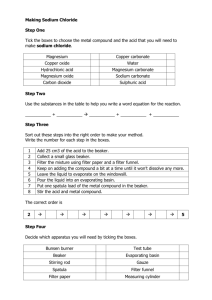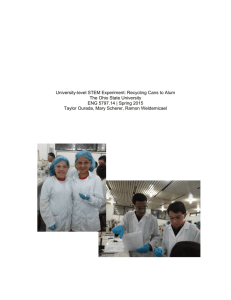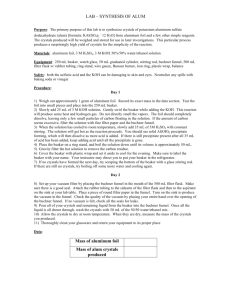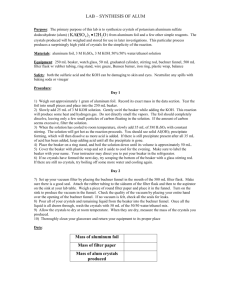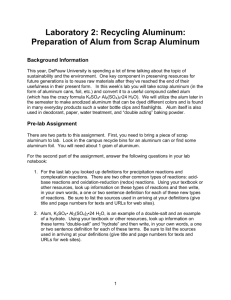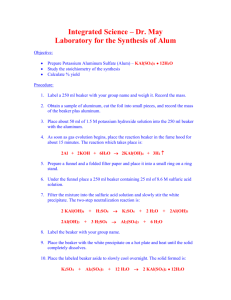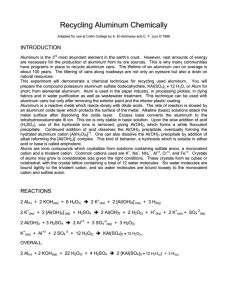Synthesis of Alum
advertisement
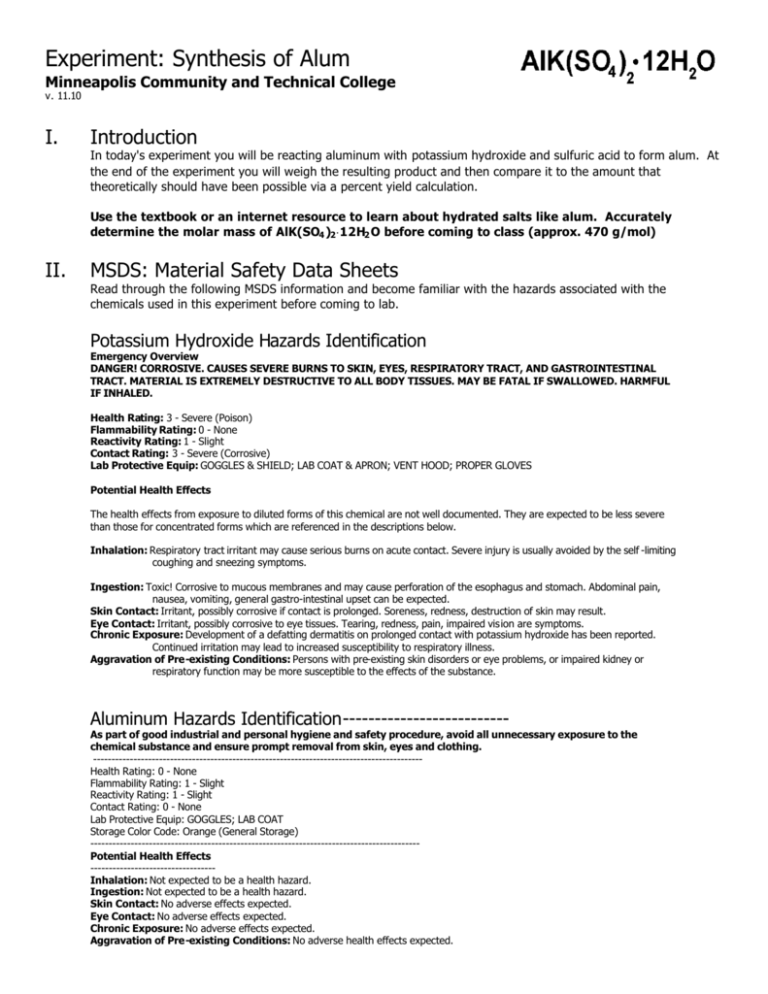
Experiment: Synthesis of Alum Minneapolis Community and Technical College v. 11.10 I. Introduction In today's experiment you will be reacting aluminum with potassium hydroxide and sulfuric acid to form alum. At the end of the experiment you will weigh the resulting product and then compare it to the amount that theoretically should have been possible via a percent yield calculation. Use the textbook or an internet resource to learn about hydrated salts like alum. Accurately determine the molar mass of AlK(SO4 )2⋅12H2 O before coming to class (approx. 470 g/mol) II. MSDS: Material Safety Data Sheets Read through the following MSDS information and become familiar with the hazards associated with the chemicals used in this experiment before coming to lab. Potassium Hydroxide Hazards Identification Emergency Overview DANGER! CORROSIVE. CAUSES SEVERE BURNS TO SKIN, EYES, RESPIRATORY TRACT, AND GASTROINTESTINAL TRACT. MATERIAL IS EXTREMELY DESTRUCTIVE TO ALL BODY TISSUES. MAY BE FATAL IF SWALLOWED. HARMFUL IF INHALED. Health Rating: 3 - Severe (Poison) Flammability Rating: 0 - None Reactivity Rating: 1 - Slight Contact Rating: 3 - Severe (Corrosive) Lab Protective Equip: GOGGLES & SHIELD; LAB COAT & APRON; VENT HOOD; PROPER GLOVES Potential Health Effects The health effects from exposure to diluted forms of this chemical are not well documented. They are expected to be less severe than those for concentrated forms which are referenced in the descriptions below. Inhalation: Respiratory tract irritant may cause serious burns on acute contact. Severe injury is usually avoided by the self -limiting coughing and sneezing symptoms. Ingestion: Toxic! Corrosive to mucous membranes and may cause perforation of the esophagus and stomach. Abdominal pain, nausea, vomiting, general gastro-intestinal upset can be expected. Skin Contact: Irritant, possibly corrosive if contact is prolonged. Soreness, redness, destruction of skin may result. Eye Contact: Irritant, possibly corrosive to eye tissues. Tearing, redness, pain, impaired vision are symptoms. Chronic Exposure: Development of a defatting dermatitis on prolonged contact with potassium hydroxide has been reported. Continued irritation may lead to increased susceptibility to respiratory illness. Aggravation of Pre-existing Conditions: Persons with pre-existing skin disorders or eye problems, or impaired kidney or respiratory function may be more susceptible to the effects of the substance. Aluminum Hazards Identification-------------------------- As part of good industrial and personal hygiene and safety procedure, avoid all unnecessary exposure to the chemical substance and ensure prompt removal from skin, eyes and clothing. -----------------------------------------------------------------------------------------Health Rating: 0 - None Flammability Rating: 1 - Slight Reactivity Rating: 1 - Slight Contact Rating: 0 - None Lab Protective Equip: GOGGLES; LAB COAT Storage Color Code: Orange (General Storage) -----------------------------------------------------------------------------------------Potential Health Effects ---------------------------------Inhalation: Not expected to be a health hazard. Ingestion: Not expected to be a health hazard. Skin Contact: No adverse effects expected. Eye Contact: No adverse effects expected. Chronic Exposure: No adverse effects expected. Aggravation of Pre-existing Conditions: No adverse health effects expected. Sulfuric Acid Hazards Identification: POISON! DANGER! CORROSIVE. LIQUID AND MIST CAUSE SEVERE BURNS TO ALL BODY TISSUE. MAY BE FATAL IF SWALLOWED OR CONTACTED WITH SKIN. HARMFUL IF INHALED. AFFECTS TEETH. WATER REACTIVE. CANCER HAZARD. STRONG INORGANIC ACID MISTS CONTAINING SULFURIC ACID CAN CAUSE CANCER. Risk of cancer depends on duration and level of exposure. Health Rating: 3 - Severe (Poison) Flammability Rating: 0 - None Reactivity Rating: 3 - Severe (Water Reactive) Contact Rating: 4 - Extreme (Corrosive) Lab Protective Equip: GOGGLES & SHIELD; LAB COAT & APRON; VENT HOOD; PROPER GLOVES Potential Health Effects Inhalation: Inhalation produces damaging effects on the mucous membranes and upper respiratory tract. Symptoms may include irritation of the nose and throat, and labored breathing. May cause lung edema, a medical emergency. Ingestion: Corrosive. Swallowing can cause severe burns of the mouth, throat, and stomach, leading to death. Can cause sore throat, vomiting, diarrhea. Circulatory collapse with clammy skin, weak and rapid pulse, shallow respirations, and scanty urine may follow ingestion or skin contact. Circulatory shock is often the immediate cause of death. Skin Contact: Corrosive. Symptoms of redness, pain, and severe burn can occur. Circulatory collapse with clammy skin, weak and rapid pulse, shallow respirations, and scanty urine may follow skin contact or ingestion. Circulatory shock is often the immediate cause of death. Eye Contact: Corrosive. Contact can cause blurred vision, redness, pain and severe tissue burns. Can cause blindness. Chronic Exposure: Long-term exposure to mist or vapors may cause damage to teeth. Chronic exposure to mists containing sulfuric acid is a cancer hazard. Aggravation of Pre-existing Conditions: Persons with pre-existing skin disorders or eye problems or impaired respiratory function may be more susceptible to the effects of the substance. Alum Hazard Identification. Emergency Overview WARNING! HARMFUL IF SWALLOWED OR INHALED. CAUSES IRRITATION TO SKIN, EYES AND RESPIRATORY TRACT. Health Rating: 1 - Slight Flammability Rating: 0 - None Reactivity Rating: 0 - None Contact Rating: 1 - Slight Lab Protective Equip: GOGGLES; LAB COAT Potential Health Effects This material hydrolyzes in water to form sulfuric acid, which is responsible for the irritating effects given below. Inhalation: Causes irritation to the respiratory tract. Symptoms may include coughing, shortness of breath. Ingestion: Causes irritation to the gastrointestinal tract. Symptoms may include nausea, vomiting and diarrhea. There have been two cases of fatal human poisonings from ingestion of 30 grams of alum. Skin Contact: Causes irritation to skin. Symptoms include redness, itching, and pain. Eye Contact: Causes irritation, redness, and pain. Chronic Exposure: No information found. Aggravation of Pre-existing Conditions: No information found. III. Experimental Procedure Suggestions: • Today, you will work individually. Work efficiently and you will finish on time. • Throughout this experiment you should strive for good laboratory technique in order to maximize your percent yield. (don't spill, follow instructions, measure carefully, etc.) Equipment and Materials • • • • • • • • • • • • • • 2 250 mL beakers (reaction vessel, grav. filter, product) 600 mL beaker (ice bath) 100 mL graduated cylinder long stem funnel (gravity filter) thermometer rubber policeman micro-spatula stirring rod Buchner Funnel Filter Funnel filterflask/rubber hose assembly Watkin #415 filter paper (Buchner: SMALL) 100 mm Watch Glass Vacuum pump • Misc. Hardware: Ringstand, clamp, iron ring, clay triangle Procedure Using an analytical balance, pre-weigh a 250 mL beaker. Use a scissors to cut up your aluminum foil and place between 0.9 g and 1.1 grams of aluminum foil pieces the beaker. Reweigh the beaker and aluminum foil to determine the mass of the aluminum to the nearest 0.0001 g. While working in the hood, use the graduated cylinder provided (in hood) to carefully add approximately 50 mL of 1.4 M KOH (potassium hydroxide) to the reaction beaker containing the aluminum foil. Continue working in the hood and warm the reaction mixture using a hotplate. (200oC). Stir the contents of the beaker with a glass stirring rod to keep the aluminum foil in solution as it will sometimes stick to the sides of the beaker. When the reaction is complete (you decide) remove the beaker from the hotplate. Record on your data sheet why you think the reaction is complete. Include DETAILS! Remove the beaker from the hotplate and allow it to cool in the hood for several minutes. Assemble the gravity filtration apparatus (figure at right) in your hood space. Your instructor will demonstrate how to flute (fold) your filter paper for this step. (below) 250 mL Beaker When cool enough to handle, pour the contents of the 250 mL reaction beaker into the gravity filtration apparatus assembled above. Use a glass stirring rod (right) to guide the liquid into the funnel. Don't overfill the funnel. Dispose of the gravity filter paper as instructed (your instructor may pick it up for you). Clean, rinse and dry the filter funnel before returning it to the ring stand. Continue working in the fume hood as you slowly pour approximately 20 mL of 9 M H2SO4 into the beaker containing the filtered liquid. Stir constantly with a glass stirring rod. Is there evidence of an exothermic or endothermic reaction? (Exothermic reactions produce heat and feel hot. Endothermic reactions take heat from the surroundings and feel cool.) Record these observations on your data sheet. Construct an ice bath from a 600 mL beaker by first filling it ¾ full with ice and then adding cold water to cover the ice. Place the 250 mL beaker containing the filtrate in the ice bath. The water in the ice bath improves contact between the ice and the 250 mL beaker and speeds up the cooling process. Place the 250 mL beaker in the ice bath and vigorously stir the mixture. Rub/scrape the sides of the beaker with a stirring rod to accelerate the formation of product crystals. !!! When no further changes are observed (~10 min.) stir the mixture and record its temperature using a thermometer!!! Vacuum Filtration In the following procedure, do not proceed until the filter flask and Buchner funnel have been clamped securely. The apparatus is very “tippy” and will fall over and break if not secured properly. Working in the hood, assemble the ring stand, clamp, and Buchner funnel as shown below. Connect the vacuum hose to the filter flask. Connect the other end of the hose to the vacuum pump inlet. Please note that you will be sharing a pump with others in the lab. Not everyone will be able to vacuum filter their products at the same time Insert a piece of round PRE- WEIGHED filter paper into the Buchner funnel (use an analytical balance). Place the filter paper in the Buchner funnel and stick it in place with a small amount of distilled water from a water bottle. Remove the 250 mL beaker from the ice bath and transfer the mixture of alum crystals and liquid to the Buchner funnel QUICKLY. This is best accomplished by first swishing/swirling the contents of the beaker and then quickly dumping the contents into the Buchner funnel. Your lab instructor will demonstrate this technique. Rinse any alum crystals that remain in the beaker to the Buchner funnel using cold distilled water and a rubber policeman (Figure at right). Rinse the alum crystals in the funnel twice with small amounts of very cold distilled water. You may turn off the vacuum pump briefly to let the alum crystals momentarily bathe in the cold water before re-applying suction. Acid Neutralization Procedure Empty the filter flask into a 100 mL graduated cylinder. Record the volume of this liquid. (“h” in data table below) Transfer the liquid from the graduated cylinder to the empty 600 mL beaker. Place the beaker in the bottom of a sink and neutralize the contents by adding scoops of solid sodium bicarbonate (NaHCO3) to the solution. Stir the reaction mixture with the glass stirring rod to insure a complete reaction. When additional NaHCO3 no longer reacts (fizzes), you can flush the beaker’s contents down the drain with lots of water. Drying the Alum Obtain a large watch glass and determine its mass to 4 decimal places using the analytical balance. Transfer the alum product and filter paper to the watch glass. The alum will need to dry for several days before you can obtain a final weight measurement. Your lab instructor will show you where to store your product until it is dry. Cleanup All glassware should be thoroughly washed and then rinsed with a small amount of distilled water. Leave the clean glassware on a dry paper towel at your bench top. Clean the Buchner funnel and filter flask by rinsing them carefully with tap water followed by a small amount of distilled water. Leave them (clean) on the cart at the front of the lab. C1151 Data Sheet Synthesis of Alum Instructor Initials_____ Name_________________________ Date of Exp. ________________ Lab Section ________________ Your individual experimental report will be due at the beginning of class next week. Data Table: All entries must be in written in ink before you leave the lab. Synthesis of Alum Data Table a. 250 mL Beaker grams b. 250 mL Beaker + aluminum grams c. aluminum (b-a) grams d. aluminum moles moles e. Molar Mass for AlK(SO4 )2•12H2 O grams/mole f. Calculated Alum Product (theoretical yield) g. recrystallization Temperature grams h. Recovered Filtrate mL i. Filter Paper grams j. Watch glass grams k. Filter Paper, Watch Glass & dry Alum (…several days later) l. Alum Product (actual yield) grams m. Alum Percent Yield (Correct S.F.) % ºC grams !!!NOTE: I will grade your data and calculations by entering your data table measurements into an Excel Spreadsheet. You will not receive full credit for your calculations unless your results match mine exactly . Observations: Record your experimental observations in the space below. Answer the following questions: • Answers must be readable and make sense for credit. • Copied/duplicate answers will result in all involved students receiving a zero score 1. What does the term “limiting reactant” mean? What was the limiting reactant in this experiment? What are the excess reactants? _________________________________________________________________________________________ _________________________________________________________________________________________ _________________________________________________________________________________________ _________________________________________________________________________________________ 2. Although most of the alum you collected in the filtration process was recovered on the filter paper, some amount of alum remained dissolved, passed through the filter paper and is now lost.. a. The amount of alum that can be dissolved in water to make a 50 mL solution is known 1.4 g of alum @ 1.0°C 1.9 g of alum @ 3.0°C 2.4g of alum @ 6.0° C Using MS Excel, construct a mass vs. temperature scatter graph using these three points. Perform a trendline analysis and attach the graph to your report. b. Use the trendline analysis result and the temperature you recorded earlier to determine how much alum should still be dissolved in 50 mL of solution at this temperature. (show your calculations) c. Adjust the mass of dissolved alum dissolved in 50 mL (previous step) for your solution’s volume (“h” in table above). (hint: use a ratio and show your calculations). d. Add the dissolved alum mass to the product weight (l) and use this value to recalculate the percent yield (Show calculations). Is the new percent yield reasonable? Why? _____________________________________________________________________________________ _____________________________________________________________________________________ _____________________________________________________________________________________ _____________________________________________________________________________________


